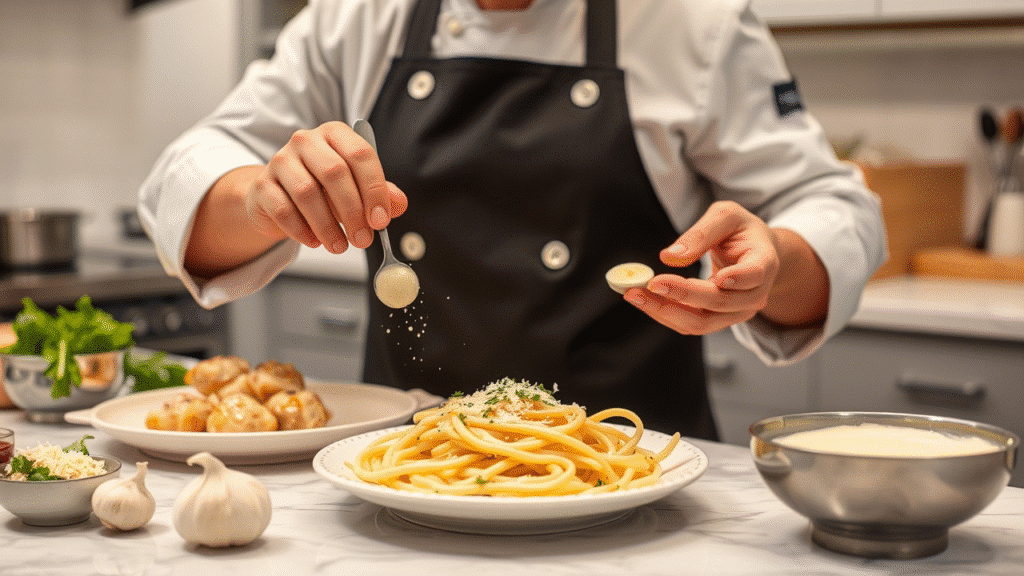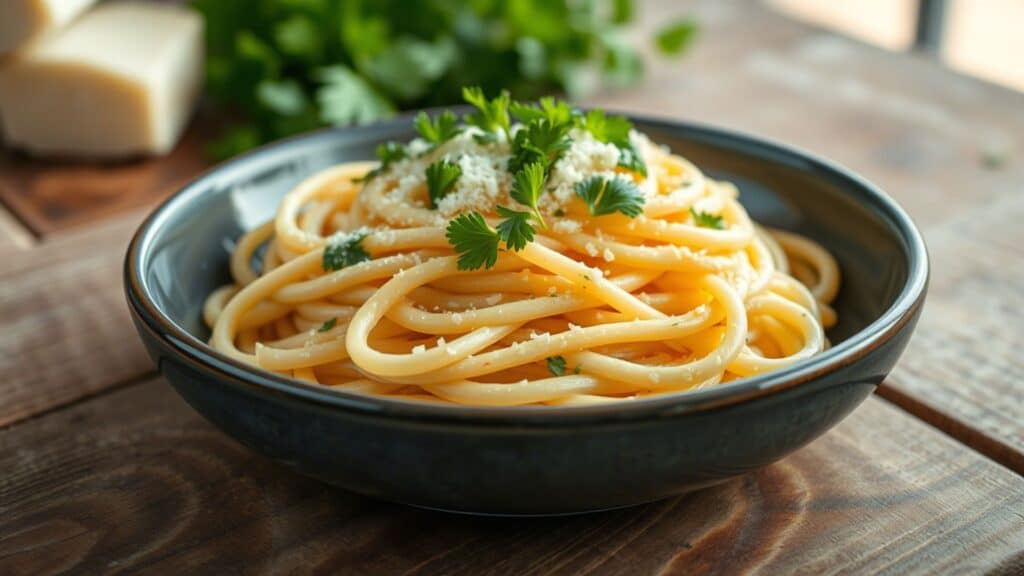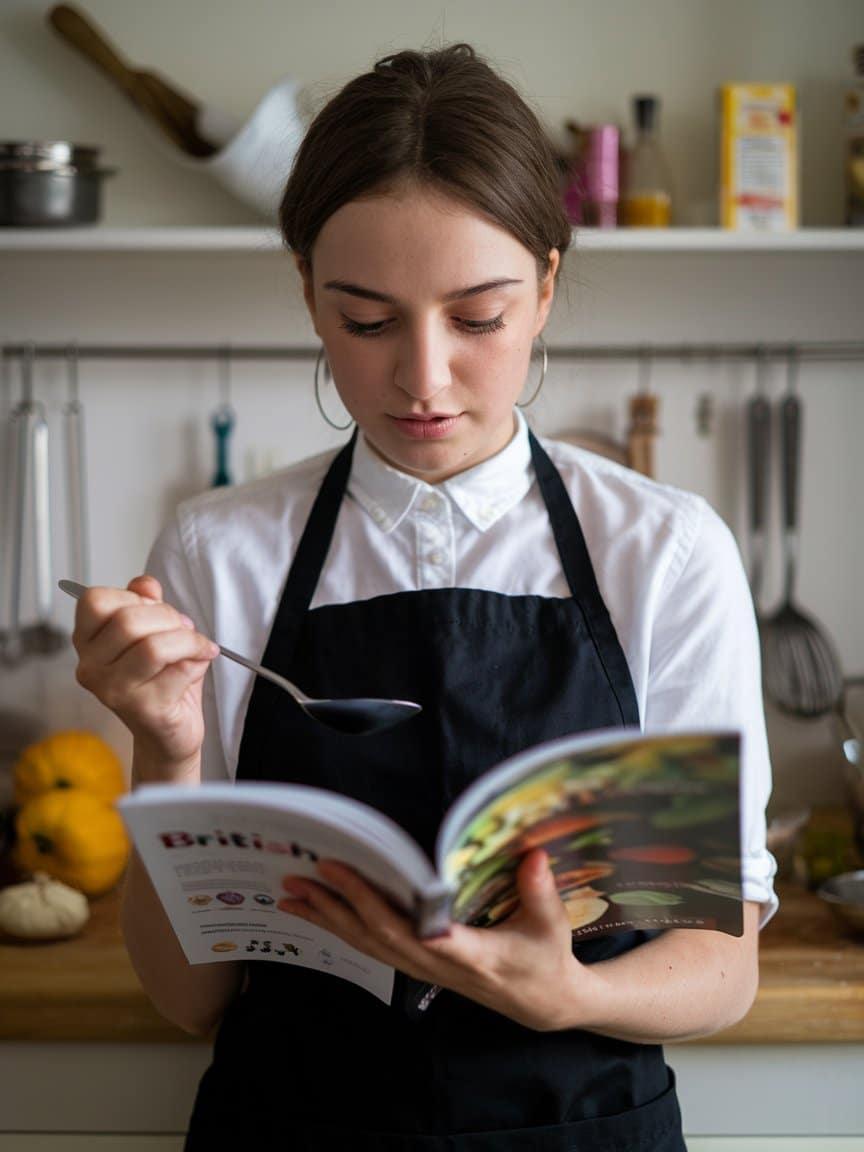The first time I witnessed a line cook reduce heavy cream over high heat without breaking it, I knew there was something magical about understanding dairy chemistry. He was making what would become our restaurant’s signature dish tender chicken bites swimming in aromatic garlic butter, nestled beside silky parmesan pasta that clung to each strand like liquid gold. That moment taught me that great cooking isn’t just about following recipes; it’s about understanding why each technique works.
This garlic butter chicken bites with creamy parmesan pasta represents the perfect marriage of technique and comfort food. What makes this dish extraordinary isn’t just its incredible flavor profile, but the way it demonstrates fundamental cooking principles that every serious cook should master. The Maillard reaction on the chicken creates complex flavors, while proper emulsification techniques ensure your cream sauce never breaks.
Understanding the Magic Behind This Dish
Garlic butter chicken bites with creamy parmesan pasta showcases three critical cooking techniques that separate amateur cooks from professionals. First, achieving the perfect sear on bite-sized chicken pieces without overcooking them requires understanding heat control and protein science. Second, creating compound butter that infuses garlic without burning demonstrates fat-soluble flavor extraction. Finally, building a proper cream sauce that incorporates cheese smoothly without seizing relies on understanding emulsification principles.
The beauty of this dish lies in its deceptive simplicity. While it appears straightforward, each component requires precise execution to achieve restaurant-quality results. The chicken must be cut to uniform sizes for even cooking, the garlic must be cooked just until fragrant, and the cream reduction must happen at exactly the right temperature to prevent separation.
Ingredients & Expert Substitutions
For the Garlic Butter Chicken Bites:
- 2 lbs boneless, skinless chicken thighs (cut into 1-inch pieces)
- 6 tablespoons unsalted European-style butter
- 8 cloves garlic, minced (not pressed)
- 2 tablespoons olive oil (extra virgin, cold-pressed)
- 1 teaspoon kosher salt
- ½ teaspoon freshly cracked black pepper
- ½ teaspoon sweet paprika
- ¼ teaspoon red pepper flakes
- 2 tablespoons fresh parsley, finely chopped
For the Creamy Parmesan Pasta:
- 1 lb fettuccine or pappardelle (fresh if possible)
- 1½ cups heavy cream (36% fat content minimum)
- 1 cup freshly grated Parmigiano-Reggiano (aged 24 months)
- ½ cup dry white wine (Sauvignon Blanc or Pinot Grigio)
- 4 tablespoons unsalted butter
- 3 cloves garlic, minced
- ¼ teaspoon white pepper
- Salt to taste
- Reserved pasta water (starchy, salted)
Professional Substitution Guide
Chicken Thighs vs. Breasts: Thighs contain more intramuscular fat and connective tissue, making them virtually impossible to overcook. If you must use breasts, reduce cooking time by 30% and monitor internal temperature religiously. Never go beyond 165°F internal temperature.
European Butter: The higher fat content (82% vs. 80% in American butter) creates richer flavor and better browning. If unavailable, add an extra tablespoon of regular butter to compensate for the moisture difference.
Fresh vs. Dried Herbs: Fresh parsley provides bright, grassy notes that dried herbs simply cannot replicate. The chlorophyll in fresh herbs also contributes to visual appeal. In a pinch, use one-third the amount of dried parsley, but add it during cooking rather than as garnish.
Cheese Selection: Authentic Parmigiano-Reggiano aged 24 months offers the perfect balance of nuttiness and saltiness. Younger cheeses lack complexity, while older ones can become grainy when melted. Avoid pre-grated cheese at all costs the anti-caking agents prevent proper melting.
Step-by-Step Professional Instructions

Preparing the Chicken (The Foundation)
Start by examining your chicken thighs carefully. Remove any excess fat, but leave some for flavor about 10% fat content is ideal. Cut against the grain into uniform 1-inch pieces. This size ensures even cooking while providing substantial bites that won’t dry out.
Season the chicken pieces 30 minutes before cooking. This isn’t just for flavor salt draws out moisture initially, then reabsorbs it along with the seasoning, creating better browning. The paprika adds color and subtle sweetness that complements the garlic beautifully.
Heat your heaviest skillet over medium-high heat until a drop of water sizzles and evaporates immediately. Add olive oil and swirl to coat. The oil should shimmer but not smoke around 350°F if you have an infrared thermometer.
The Searing Process (Critical Technique)
Add chicken pieces in a single layer, leaving space between each piece. Overcrowding creates steam instead of searing, and you’ll end up with gray, flavorless chicken. Work in batches if necessary. The initial sizzle should be aggressive but not violent.
Don’t move the chicken for the first 2-3 minutes. This allows proper browning through the Maillard reaction, which creates hundreds of flavor compounds. When you can lift a piece easily with tongs, it’s ready to flip. If it sticks, it needs more time.
After flipping, cook for another 2-3 minutes until the internal temperature reaches 165°F. Remove chicken to a plate and tent with foil. Don’t skip this resting period it allows juices to redistribute throughout the meat.
Building the Garlic Butter (Flavor Development)
Reduce heat to medium-low and add butter to the same pan. The residual fond (browned bits) will dissolve into the butter, creating incredible depth. As the butter melts, it should foam slightly but never turn brown.
Add minced garlic when the butter stops foaming. Fresh garlic contains volatile sulfur compounds that dissipate quickly under high heat, so timing is crucial. Cook just until fragrant about 30 seconds. Overcooked garlic becomes bitter and acrid.
Return chicken to the pan and toss gently to coat. The butter should cling to each piece without pooling. Add red pepper flakes and half the parsley now the residual heat will bloom the spices without burning them.
Pasta Perfection (The Supporting Star)
While the chicken rests, start your pasta water. Use at least 6 quarts of water with 2 tablespoons of kosher salt. The water should taste like mild seawater. Bring to a rolling boil before adding pasta.

Cook pasta 1-2 minutes less than package directions indicate. It will finish cooking in the cream sauce, absorbing flavors while maintaining perfect texture. Reserve 2 cups of pasta water before draining this starchy liquid is gold for sauce consistency.
Creating the Cream Sauce (Advanced Technique)
In a large saucepan, melt butter over medium heat. Add minced garlic and cook until fragrant, about 30 seconds. The key here is gentle heat aggressive cooking will break the emulsion later.
Add white wine and cook until reduced by half. This concentrates flavor while cooking off harsh alcohol notes. The reduction should smell fruity and complex, not sharp or boozy.
Pour in heavy cream and bring to a gentle simmer. Never boil cream sauces the proteins will curdle and create an unpleasant texture. Maintain temperature around 180-185°F if you have a thermometer.
The Cheese Integration (Technical Mastery)
Remove the cream from heat before adding cheese. Hot cream will cause the proteins in parmesan to seize, creating a grainy texture that’s impossible to fix. Let the cream cool for 30 seconds.
Add cheese in small handfuls, whisking constantly. Each addition should melt completely before adding more. The sauce should become glossy and coat a spoon evenly. If it appears grainy, it’s too hot remove from heat entirely and whisk vigorously.
Adjust consistency with reserved pasta water, one tablespoon at a time. The starches in pasta water help bind the sauce while thinning it. Season with white pepper and salt to taste.
Cooking Science & Professional Insights
Understanding Protein Coagulation
Chicken proteins begin denaturing at 140°F, but collagen doesn’t fully break down until 160°F. This is why thighs, with their higher collagen content, remain juicy even when fully cooked. The key is managing the rate of temperature increase slow and steady prevents moisture loss.
Emulsification Principles
Cream sauces rely on fat-in-water emulsions stabilized by proteins and starches. Butter provides lecithin (an emulsifier), while pasta water contributes starches that help bind the sauce. Temperature control prevents protein denaturation that would break the emulsion.
Garlic Chemistry
Garlic contains alliin, which converts to allicin when crushed. Heat further transforms allicin into various sulfur compounds, each with different flavor profiles. Quick cooking preserves the sharp, pungent notes, while longer cooking develops sweeter, nuttier flavors.
The Maillard Reaction
Proper searing creates the Maillard reaction between amino acids and reducing sugars. This occurs optimally between 280-330°F, which is why proper heat control is essential. The hundreds of compounds created during this process provide the complex, savory flavors that make this dish memorable.
Essential Equipment Considerations
Heavy-Bottomed Skillet: Even heat distribution prevents hot spots that can burn garlic or chicken. Cast iron or tri-ply stainless steel work best. Non-stick pans don’t achieve proper browning temperatures.
Sharp Knife: Clean cuts prevent cell damage that releases excess moisture. Dull knives crush rather than cut, leading to uneven cooking and poor texture.
Fine Microplane: Fresh cheese grates more evenly with a microplane, melting smoother than roughly grated cheese. The uniform particle size ensures consistent sauce texture.
Plating & Presentation Excellence
Restaurant-Style Plating
Warm your plates in a 200°F oven for 2-3 minutes. Hot plates keep the dish at optimal serving temperature longer. Use tongs to create a nest of pasta in the center of each plate, allowing height and visual interest.
Arrange chicken bites around the pasta, ensuring each portion gets equal amounts. Drizzle any remaining garlic butter around the plate’s edge. Garnish with remaining fresh parsley and a light dusting of freshly grated parmesan.
Wine & Pairing Suggestions
Wine Pairings: The richness of this dish calls for wines with good acidity to cut through the cream. Chardonnay with oak provides complementary buttery notes, while Pinot Grigio offers crisp contrast. For reds, try Barbera d’Alba its high acidity and moderate tannins won’t clash with the cream.
Side Dish Recommendations: Keep sides simple to let the main dish shine. A lightly dressed arugula salad provides peppery contrast, while roasted asparagus adds color and textural variety. Crusty bread is essential for sopping up the incredible sauce.
Troubleshooting Common Issues
Broken Cream Sauce
If your sauce separates, immediately remove from heat and whisk in cold butter, one tablespoon at a time. The cold fat helps re-emulsify the mixture. Prevention is better never let cream sauces boil.
Dry Chicken
Overcooked chicken is unfortunately irreversible, but you can mask dryness by ensuring each piece is well-coated with the garlic butter. Next time, use a meat thermometer and remove chicken at 160°F carryover cooking will bring it to 165°F.
Grainy Cheese Sauce
Temperature is usually the culprit. Remove from heat completely and whisk in a tablespoon of cold heavy cream. The proteins may partially salvage, though texture won’t be perfect. Always add cheese off heat.
Advanced Variations & Creative Twists

Protein Alternatives
Shrimp: Substitute large shrimp (16-20 count) for chicken. Cook for 2-3 minutes per side until pink. The natural sweetness pairs beautifully with garlic butter.
Pork Tenderloin: Cut into medallions and pound to ½-inch thickness. The lean meat requires careful temperature monitoring to prevent drying.
Flavor Variations
Mediterranean Style: Add sun-dried tomatoes, kalamata olives, and fresh basil. The acidity brightens the rich cream sauce.
Cajun Influence: Incorporate smoked paprika, oregano, and a touch of cayenne. The smoky heat complements the creamy pasta beautifully.
Dietary Modifications
Gluten-Free: Use high-quality gluten-free pasta made from rice and corn. Cook 1 minute longer than package directions GF pasta needs extra time to achieve proper texture.
Lower Fat: Replace heavy cream with half-and-half mixed with cornstarch (2 teaspoons per cup). The texture won’t be identical, but it’s a reasonable compromise.
Storage & Reheating Strategies
Proper Storage
Refrigerate within 2 hours of cooking. Store chicken and pasta separately if possible this prevents the pasta from absorbing too much sauce and becoming mushy. Properly stored, both components keep for 3-4 days.
Reheating Techniques
Never microwave cream sauces they’ll break and become grainy. Instead, reheat gently in a saucepan over low heat, adding pasta water as needed to restore consistency. Reheat chicken separately to prevent overcooking.
For best results, bring components to room temperature before reheating. This ensures even warming and prevents shock that can break emulsions.
Conclusion: Mastering Fundamental Techniques
This garlic butter chicken bites with creamy parmesan pasta recipe represents far more than a simple weeknight dinner. It’s a masterclass in fundamental cooking techniques that every serious cook should understand. The proper searing technique, emulsification principles, and flavor layering demonstrated here apply to countless other dishes.
The key to success lies in understanding the why behind each step. When you know that proteins coagulate at specific temperatures, that emulsions require careful temperature control, and that garlic’s flavor compounds develop differently under various heat levels, you’re not just following a recipe you’re cooking with intelligence and purpose.
Perfect this dish, and you’ll have mastered techniques that will elevate your entire cooking repertoire. The confidence gained from understanding these principles will transform you from someone who follows recipes to someone who truly cooks.
Frequently Asked Questions?
Can I make this dish ahead of time?
While this dish is best served immediately, you can prep components separately. Cook the chicken completely and store refrigerated for up to 2 days. Make the cream sauce base (without cheese) and refrigerate. When ready to serve, reheat the sauce gently, add cheese off heat, and warm the chicken separately.
Why does my cream sauce keep breaking?
Temperature is the most common culprit. Cream sauces should never boil maintain temperatures around 180°F. Also, always remove from heat before adding cheese, and add it gradually while whisking constantly. Using freshly grated cheese instead of pre-shredded also helps prevent breaking.
Can I substitute chicken breasts for thighs?
Yes, but adjust your technique. Chicken breasts cook faster and dry out more easily. Cut them slightly larger (1¼-inch pieces) and reduce cooking time by about 30%. Use a meat thermometer and remove at exactly 165°F internal temperature.
What’s the best pasta shape for this dish?
Fettuccine and pappardelle work best because their wide, flat surfaces hold the cream sauce beautifully. Avoid thin pastas like angel hair, which become overwhelmed by the rich sauce. Rigatoni or penne can work if you prefer tube shapes their ridges grab onto the sauce nicely.
How do I know when the garlic is perfectly cooked?
Garlic should be fragrant and just beginning to turn golden around the edges this takes about 30 seconds in hot butter. It should sizzle gently, not aggressively. If it starts browning quickly, reduce heat immediately. Burned garlic tastes bitter and will ruin the entire dish.

Veronica is a passionate food enthusiast with over three years of experience in exploring and writing about diverse cuisines. Her expertise lies in reviewing restaurants, sharing creative recipes, and discovering the latest food trends. As the voice behind FoodieRecap.com, Anju brings fresh perspectives and culinary insights to her audience.
